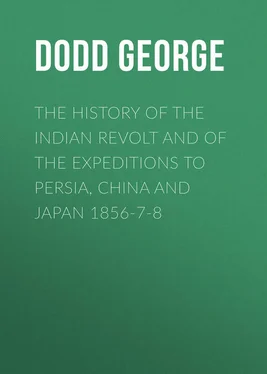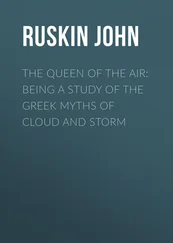George Dodd - The History of the Indian Revolt and of the Expeditions to Persia, China and Japan 1856-7-8
Здесь есть возможность читать онлайн «George Dodd - The History of the Indian Revolt and of the Expeditions to Persia, China and Japan 1856-7-8» — ознакомительный отрывок электронной книги совершенно бесплатно, а после прочтения отрывка купить полную версию. В некоторых случаях можно слушать аудио, скачать через торрент в формате fb2 и присутствует краткое содержание. Жанр: foreign_antique, foreign_prose, на английском языке. Описание произведения, (предисловие) а так же отзывы посетителей доступны на портале библиотеки ЛибКат.
- Название:The History of the Indian Revolt and of the Expeditions to Persia, China and Japan 1856-7-8
- Автор:
- Жанр:
- Год:неизвестен
- ISBN:нет данных
- Рейтинг книги:3 / 5. Голосов: 1
-
Избранное:Добавить в избранное
- Отзывы:
-
Ваша оценка:
- 60
- 1
- 2
- 3
- 4
- 5
The History of the Indian Revolt and of the Expeditions to Persia, China and Japan 1856-7-8: краткое содержание, описание и аннотация
Предлагаем к чтению аннотацию, описание, краткое содержание или предисловие (зависит от того, что написал сам автор книги «The History of the Indian Revolt and of the Expeditions to Persia, China and Japan 1856-7-8»). Если вы не нашли необходимую информацию о книге — напишите в комментариях, мы постараемся отыскать её.
The History of the Indian Revolt and of the Expeditions to Persia, China and Japan 1856-7-8 — читать онлайн ознакомительный отрывок
Ниже представлен текст книги, разбитый по страницам. Система сохранения места последней прочитанной страницы, позволяет с удобством читать онлайн бесплатно книгу «The History of the Indian Revolt and of the Expeditions to Persia, China and Japan 1856-7-8», без необходимости каждый раз заново искать на чём Вы остановились. Поставьте закладку, и сможете в любой момент перейти на страницу, на которой закончили чтение.
Интервал:
Закладка:
Vocabulary. – We here present a vocabulary of about fifty words much used in India, both in conversation and in writing, connected with the military and social life of the natives; with the initials or syllables P., Port., H., M., A., T., Tam., S., to denote whether the words have been derived from the Persian, Portuguese, Hindustani, Mahratta, Arabic, Tatar, Tamil, or Sanscrit languages. Tamil or Tamul is spoken in some of the districts of Southern India. In most instances, two forms of spelling are given, to prepare the reader for the discrepancies above adverted to:
Ab , aub (P.), water; used in composition thus: Punjaub , five waters, or watered by five rivers; Doab , a district between two rivers, equivalent in meaning to the Greek Mesopotamia .
Abad (P.), inhabited; a town or city; such as Allahabad , city of God; Hyderabad , city of Hyder.
Ayah (Port.), a nurse; a female attendant on a lady.
Baba (T.), a term of endearment in the domestic circle, nearly equivalent to the English dear , and applied both to a father and his child.
Baboo , a Hindoo title, equivalent to our Esquire .
Bag , bágh , a garden; Kudsiya bágh is a celebrated garden outside Delhi.
Bahadoor (P.), brave; a title of respect added to the names of military officers and others.
Bang (P.), an intoxicating potion made from hemp.
Bazar , bazaar , an exchange or market-place.
Begum (T.), a princess, a lady of high rank.
Bheestee , bihishtí , a water-carrier.
Bobachee , báwarchí (T.), an Indian officer’s cook.
Budgerow , bajrá (S.), a Ganges boat of large size.
Bungalow , banglá (H.), a house or dwelling.
Cherry , cheri (Tam.), village or town; termination to the name of many places in Southern India; such as Pondicherry .
Chit , chittí (H.), a note or letter.
Chupatty , chápátí (P.), a thin cake of unleavened Indian-corn bread.
Coolie , kuli (T.), a porter or carrier.
Cutcherry , kacharí (H.), an official room; a court of justice.
Dacoit , dákáit (H.), a gang-robber.
Dâk , dahk , dawk (H.), the Indian post, and the arrangements connected with it.
Dewan , a native minister or agent.
Dost (P.), a friend.
Feringhee , a Frank or European.
Fakeer , fakír (A.), a mendicant devotee.
Ghazee , ghazi (A.), a true believer who fights against infidels: hence Ghazeepoor , city of the faithful.
Golundauze , golandáz (P.), a native artilleryman.
Havildar (P.), a native sergeant.
Jehad (A.), a holy war.
Jemadar (P.), a native lieutenant.
Jhageerdar , jaghiredar , jágírdár (P.), the holder of land granted for services.
Mohurrum (A.), a fast held sacred by Mohammedans on the tenth day of the first month in their year, equivalent to the 25th of July.
Musjid (A.), a mosque; thence jumma musjid or jum’aah masjid , a cathedral or chief mosque.
Naik , naig (S.), a native corporal.
Náná , nena (M.), grandfather, a term of respect or precedence among the Mahrattas; Náná Sahib , so far from being a family or personal name, is simply a combination of two terms of respect (see Sahib ) for a person whose real name was Dhundu Punt.
Nawab , nabob , núwáb (A.), derived from náib , a viceroy or vicegerent.
Nuddee , nadi (S.), a river.
Nullah , nálá (H.), a brook, water-course, the channel of a torrent.
Patam , pattanam (S.), a town; the termination of the names of many places in Southern India; such as Seringapatam , the city of Shrí Ranga, a Hindoo divinity.
Peon (P.), a messenger or foot-attendant.
Pore , poor , a town; the final syllable in many significant names, such as Bhurtpore or Bharatpoor , the town of Bharata.
Rajpoot , a Hindoo of the military caste or order; there is one particular province in Upper India named from them Rajpootana .
Ryot , a peasant cultivator.
Sahib , saheb , sáaib (A.), lord; a gentleman.
Sepoy , sípahí , in the Bengal presidency, a native soldier in the Company’s service; in that of Bombay, it often has the meaning of a peon or foot-messenger.
Shahzadah (P.), prince; king’s son.
Sowar (P.), a native horseman or trooper.
Subadar , soubahdar (A.), a native captain.
Tuppal , tappál (H.), a packet of letters; the post.
Zemindar , zamindár (P.), a landowner.
CHAPTER I.
THE ANGLO-INDIAN ARMY AT THE TIME OF THE OUTBREAK
The magnificent India which began to revolt from England in the early months of 1857; which continued that Revolt until it spread to many thousands of square miles; which conducted the Revolt in a manner that appalled all the civilised world by its unutterable horrors – this India was, after all, not really unsound at its core. It was not so much the people who rebelled, as the soldiers . Whatever grievances the hundred and seventy millions of human beings in that wonderful country may have had to bear; whatever complaints may have been justifiable on their parts against their native princes or the British government; and whatever may have been the feelings of those native princes towards the British – all of which matters will have to be considered in later chapters of this work – still it remains incontestable that the outbreak was a military revolt rather than a national rebellion. The Hindoo foot-soldier, fed and paid by the British, ran off with his arms and his uniform, and fought against those who had supported him; the Mohammedan trooper, with his glittering equipments and his fine horse, escaped with both in like manner, and became suddenly an enemy instead of a friend and servant. What effect this treachery may have had on the populace of the towns, is another question: we have at present only to do with the military origin of the struggle.
Here, therefore, it becomes at once necessary that the reader should be supplied with an intelligible clue to the series of events, a groundwork on which his appreciation of them may rest. As this work aims at something more than a mere record of disasters and victories, all the parts will be made to bear some definite relation one to another; and the first of these relations is – between the mutinous movements themselves, and the soldiers who made those movements. Before we can well understand what the sepoys did , we must know who the sepoys are ; before we can picture to ourselves an Indian regiment in revolt, we must know of what elements it consists, and what are its usages when in cantonments or when on the march; and before we can appreciate the importance of two presidential armies remaining faithful while that of Bengal revolted, we must know what is meant by a presidency, and in what way the Anglo-Indian army bears relation to the territorial divisions of India. We shall not need for these purposes to give here a formal history of Hindostan, nor a history of the rise and constitution of the East India Company, nor an account of the manners and customs of the Hindoos, nor a narrative of the British wars in India in past ages, nor a topographical description of India – many of these subjects will demand attention in later pages; but at present only so much will be touched upon as is necessary for the bare understanding of the facts of the Revolt, leaving the causes for the present in abeyance.
Читать дальшеИнтервал:
Закладка:
Похожие книги на «The History of the Indian Revolt and of the Expeditions to Persia, China and Japan 1856-7-8»
Представляем Вашему вниманию похожие книги на «The History of the Indian Revolt and of the Expeditions to Persia, China and Japan 1856-7-8» списком для выбора. Мы отобрали схожую по названию и смыслу литературу в надежде предоставить читателям больше вариантов отыскать новые, интересные, ещё непрочитанные произведения.
Обсуждение, отзывы о книге «The History of the Indian Revolt and of the Expeditions to Persia, China and Japan 1856-7-8» и просто собственные мнения читателей. Оставьте ваши комментарии, напишите, что Вы думаете о произведении, его смысле или главных героях. Укажите что конкретно понравилось, а что нет, и почему Вы так считаете.












